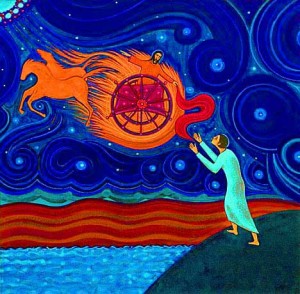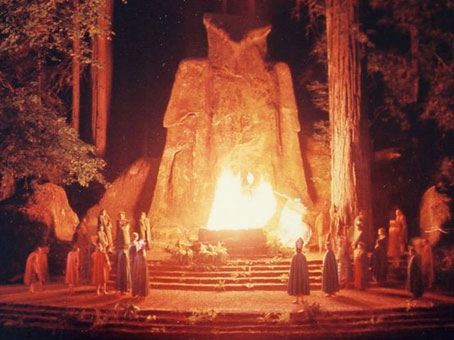Apr
8
2009
The book of Daniel begins with the captured vessels from Solomon’s Temple being carried off to Babylon. We assume the ark, with its solid gold lid, was melted down. The golden lampstand, however, shows up at Belshazzar’s feast just before the fall of Babylon to Persia. Cyrus decrees that the Jews can return and rebuild the Temple. They carry the vessels, minus the Ark, across the Great River Euphrates.
Zechariah later sees a flying scroll with the dimensions of the Tabernacle (10 x 20 cubits). These are also the dimensions of the Ark plus cherubim in Solomon’s Temple. The Ark had been offered as an ascension and created a new heaven – unrolled a new scroll. The Restoration Covenant cost the Ark its “life.”
Now to Acts. The human Ark, Jesus, had ascended to heaven and left the “seven churches”, the New Covenant Lampstands with tongues of fire, to rule and conquer Babylon (Jerusalem). The church did so, and we see the firstfruits church army, the “kings from the sunrising” crossing the Great River in Revelation 16, entering a new earth like Joshua over Jordan.
Comments Off | tags: Ark of the Covenant, Babylon, Daniel, Exile, Lampstand, Revelation, Stephen, Tabernacle, Temple, Zechariah | posted in Biblical Theology, The Last Days
Apr
8
2009
 They sent therefore fifty men. And for three days they sought [Elijah] but did not find him. And they came back to [Elisha] while he was staying at Jericho, and he said to them, “Did I not say to you, ‘Do not go’?” (2 Kings 2:17-18)
They sent therefore fifty men. And for three days they sought [Elijah] but did not find him. And they came back to [Elisha] while he was staying at Jericho, and he said to them, “Did I not say to you, ‘Do not go’?” (2 Kings 2:17-18)
It seems the Ark was “taken” like Enoch. If it was carried to Babylon, perhaps it was melted down with other conquered “gods” to contribute to Nebuchadnezzar’s “golden calf.” It fits the pattern if the Ark “died” on the altar of false worship “outside the city.” Continue reading
Comments Off | tags: Ark of the Covenant, Babylon, Daniel, Elijah, Elisha, Enoch, Jericho, Jezebel, Lampstand, Michael O'Brien, Nebuchadnezzar, Revelation, Zechariah | posted in Biblical Theology, The Restoration Era, Totus Christus
Apr
8
2009
 During the Creation week, there were three days of forming new “empty spaces” by dividing the original watery deep (the Abyss), then three days of filling them. A ‘world model’ develops with God’s throne at the top and the Abyss at the bottom, the place furthest from the throne. The architecture of the Tabernacle follows this model, laid out upon the ground.
During the Creation week, there were three days of forming new “empty spaces” by dividing the original watery deep (the Abyss), then three days of filling them. A ‘world model’ develops with God’s throne at the top and the Abyss at the bottom, the place furthest from the throne. The architecture of the Tabernacle follows this model, laid out upon the ground.
When the priesthood – the Land-mediators – disobeyed God, the Abyss was dredged up to cover the Land (holy place). We see this first in the flood, and later in the invasions of Assyria, Babylon and Rome.
The Valley of Hinnom became a symbol of the ‘Abyss’ below the true mountain of God. As an evil twin of the holy place, it was an ‘Adamic’ clay pit with no glorious metal. It was also the place where Judah sacrificed their infants to false gods. It was counterfeit worship in the tabernacle of hell, and the Lord said He would fill it with their bodies. Their dark ‘table of showbread’ became a snare. [Read Jeremiah 19]
After the Babylonian captivity, Zechariah saw the church in “the deep” (often translated valley or glen). A new Land-altar was rising out of the ‘waters’ – a new mountain of God, with a new Eden-temple to mediate for the world.
TAOTA
Comments Off | tags: Altar of the Abyss, Babylon, Creation Week, Exile, Gehenna, Jeremiah, Priesthood, Tabernacle, Table of Showbread, The flood, Zechariah | posted in Biblical Theology, The Restoration Era
Apr
8
2009
“…though Jews returned to the land after the decree of Cyrus, they did not enjoy the fruits of it (Haggai 1:1-11). They were still alienated from the land. They did not really occupy it until they rebuilt the Temple, which was completed in the sixth year of Darius, 20 years later.”1
Darius listened to those who opposed the Jews and ordered the Temple reconstruction to officially cease, so the Lord raised up two witnesses, Haggai and Zechariah. Haggai would chastise the people for neglecting the house of God, and stir up their hearts to finish it. Zechariah would deal with the spiritual war going on behind the scenes.
Zechariah’s visions perform the same function as Abram’s animal sacrifice. (In Abram’s time, there was a famine in the Land, and later it did not support Abram and Lot’s flocks). In Zechariah, the mediator who is “passed over” is not Abram but Joshua the High Priest. The sins are atoned for again, but not with animal sacrifices. In Zechariah it is the Angel of the Lord who steps in, chases away the accusations of Satan (as the ravens), and provides clean robes as a New Covenant.
Then the Temple could be completed, and the abundant fruits of a recreated Land were enjoyed by a new Israel.
________
1 James B. Jordan, Jubilee,
Biblical Chronology Vol. 5, No. 4, www.biblicalhorizons.com
Comments Off | tags: Abraham, Atonement, Covenant curse, Cyrus, Darius, Famine, Haggai, High Priest, James Jordan, Lot, Temple, Two witnesses, Zechariah | posted in The Restoration Era



























